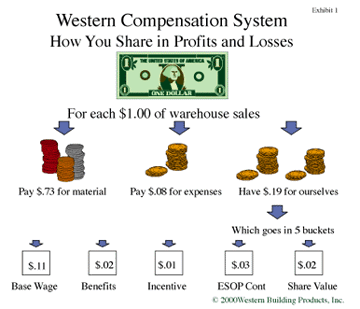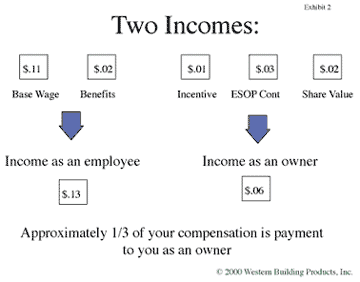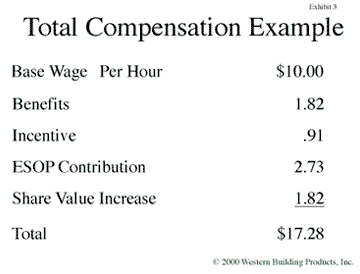by William L. Nicholson, President, Western Building Products, Inc.
© 2002 Western Building Products, Inc.
In 1983, Western Building Products, Inc. embarked on a journey on the path of economic and social justice with the implementation of an Employee Stock Ownership Plan (ESOP). With the help of valued advisors and the core of knowledge provided by the Center for Economic and Social Justice, we have advanced on the path, but are very aware that the work is never done. While we started the journey driven by a desire to do the right thing, we found doing the right thing also has made us a very competitive business. We share the status of our journey with you in the hopes that it may provide guidance to other businesses.
Western Building Products, Inc. is first, and foremost an organization of people. It is, secondly, a regional distributor of millwork, located in Milwaukee, WI. As a distributor, it employs 275 people with sales in excess of $100,000,000.
As an organization of people, Western’s stated purpose is to make a difference in five areas:
To provide a civil workplace in an uncivil world;
To provide community in an individualistic society;
To challenge people to grow and contribute and reject entitlement;
To provide job security, when the norm is insecurity;
To provide well-paying jobs despite the widening gulf between high and low income families.
The means to this end is being a professional millwork services provider, meeting our customers’ requirements and contributing to higher quality and higher value homes.
The underlying bedrock beliefs that are the glue that binds this organization are:
We believe its employees, through an ESOP, should own the company and continue as an ESOP-owned company from generation to generation of employees.
We believe in a system of checks and balances for the ESOP with an outside trustee, outside representation on the board of directors, and the corporate officers as ESOP administrators.
We believe that profit is what we make before we pay ourselves anything and 100% of profit should be distributed each year in one of five ways: a competitive base wage, company-paid benefits, variable pay based on performance, the ESOP contribution, and retention of any excess by the company which correlates with increases in the value of the stock.
We believe there should be a low multiple of high to low wages and individual earnings should be based on merit.
We believe the employee-owners of the company should be given the opportunity to be actively involved in the company.
We believe the company has to provide continuous learning opportunities for our people in millwork knowledge, management skills, industry knowledge, and job skills.
We believe the officers of the company must lead and manage the company by serving its employee-owners.
Defining its core values as expected behaviors (you can count on me to behave in this manner), Western categorizes them in two tiers: 1) those expected behaviors necessary to become a member of the organization, and 2) those expected behaviors that need to be developed and in place to be able to have a long-term relationship with the organization:
Necessary to become a member of the organization
Non-violent
Honest
Positive/Constructive
Necessary for a long-term relationship with the organization:
Strong work ethic
Active participation
Desire to continually learn
Development of required skills.
Our stated purpose, bedrock beliefs, and core values provides the structure of our organization. Three very important systems provide the day to day implementation of the organization: our management system, our communication system, and our decision-making systems. These are defined as follows:
Management system:
1. Management has to be a team;
2. For all functions and processes, someone has to be in charge;
3. Treat people right;
4. Use people’s strengths; compensate for their weaknesses;
5. Ask people their opinion;
6. Keep people informed;
7. Tell people exactly what’s expected of them;
8. Hold people accountable.
Communication system:
1. You can talk to anyone you want; if you’re talking to the wrong person, you’ll be directed to the right one;
2. Quarterly manager review and roundtables
3. Quarterly employee-owner focus group review and roundtables;
4. Annual employee-owner small-group update meetings;
5. Regularly scheduled manager, department, and cross-functional meetings;
6. Ad hoc groups formed as necessary.
Decision-making system:
1. Make decisions as close to the job as possible;
2. Make consensus decisions when possible;
3. The final responsibility for decisions lies with the person in charge.
Our practices and procedures also guide the day to day operation of the business.
Some of these practices and procedures that have been most helpful to building our organization are:
1. Compensation system — as stated earlier, profit is what we make before we pay ourselves anything. Profit is distributed 100% each year to the employee-owners of the company in one of five ways (see exhibit 1). Our compensation system also clarifies what part of the compensation is a return on labor (income as an employee) and what part is a return on capital (income as an owner) (see exhibit 2). We emphasize total compensation to our employee-owners and give each person a report of their total compensation each year (see exhibit 3).



2. New employee orientation — we emphasize employee-ownership from the first day of employment. One of the orientation sessions that is the source of good feedback is a meeting of a small group of new employees with the two officers of the company. At that time, they are given a copy of the organization’s stated purpose with an explanation from the officers. The new employees are asked to keep a copy of it at their workplace and if they ever feel the organization is falling short, they should let us know.
3. Flow of information — at the beginning of each year the officers and two key managers meet with all employees in small groups to review the performance of the last year, the projections for the coming year and other important developments. At the end of the update, we do a roundtable discussion asking for questions, input, and a status report from each participant. These meetings take several months to complete. During the course of the year, operating performance is reviewed with managers, in detail, quarterly, and with two or three focus groups of employees, who are then asked to help communicate the information. We are a company that has a lot of meetings, regularly scheduled and on an ad hoc basis. We believe that active, on-going dialogue is an important part of our organization and we build in structures to be sure it happens on a regular basis.
4. Incentive compensation — this is a group plan based on productivity. Half of the bonus is paid out in the month earned and the other half set aside for a year-end bonus. Each person in the company receives the same percentage of their earnings as a bonus. In addition to the additional compensation, this also very effectively communicates how the company did the past month. The larger the incentive check, the better we did.
Putting all these pieces together forms the culture of our organization, which we would describe as outspoken, for the right reasons; people care.
We offer the following measurements as a means to appraise our success in implementing our organization plan:
1. 2001 will be the nineteenth consecutive year that we have contributed 25% of each employee-owner’s W2 to his or her ESOP account. People who have been with the organization since the inception of our ESOP now have accounts with significant balances.
2. The value of the company’s stock has increased an average of 13.2% per year since 1983.
3. The debt to equity ratio has been reduced from 4.7, in 1976, to 0.9.
4. Sales have increased from $14,500,000 in 1983 to $102,000,000 in 2000.
5. Employment has increased from 38 in 1982, to 275 today.
6. The ratio of the highest income to the average income is 3.8. The ratio of the top 20% of incomes to the bottom 20% of incomes is 2.6 (the national average is 10.6).
7. The ownership of the company is widely disbursed with no one having more than a 3.5% ownership interest.
More important than financial measures are the individual stories of the people at Western, which are far too numerous to mention. However, two stories will serve as a representative of all of our stories:
ESOP reports are distributed to employee-owners each year. When a person receives their first statement, their manager reviews it personally with them. Again in the seventh year, when a person becomes fully vested, the manager reviews the statement personally and informs them it is now all theirs. After informing an employee-owner this year that the account was fully vested, the manager reported back that she cried, saying, “I’ve never had anything before”.
A friend recently told me he was shopping at one of our customer’s yards when our truck pulled in. He went over to our driver and asked how he liked to work at Western. The response was, “I don’t work there, I’m an owner”.
We have had our share of successes and failures along the way. Whenever we fall short, we are committed to picking ourselves up, refocusing, and continuing along the way.
We thank everyone who has crossed our path and had a part in leading us to the path of economic and social justice and the most exciting journey we will ever experience.
ADDITIONAL SOURCES ON JUSTICE-BASED MANAGEMENT(SM)
For more information on Justice-Based Management(SM) and building an ownership culture, contact Equity Expansion International, Inc. at P.O. Box 40711, Washington, D.C. 20016, (Tel) 703-243-5155, (Fax) 703-243-5935, (Eml) info@eei-consultants.com, (Web) http://www.eei-consultants.com.
Also see:
“Justice-Based Management: A Framework for Equity and Efficiency in the Workplace” [pp. 189-210 in Curing World Poverty: The New Role of Property. [Originally titled, “Value-Based Management: A Framework for Equity and Efficiency in the Workplace.”] Available for $15 plus $3.00 shipping and handling (in U.S.) from the Center for Economic and Social Justice, P.O. Box 40711, Washington, D.C., (Tel) 703-243-5155, (Fax) 703-243-5935, (Eml) thirdway@cesj.org, (Web) https://www.cesj.org.
“Beyond Privatization: An Egyptian Model for Democratizing Capital Credit for Workers” [pp. 247-258 in Curing World Poverty: The New Role of Property ] See above.
Journey to an Ownership Culture: Insights from the ESOP Community, ed. Dawn Kurland Brohawn, published by Scarecrow Press and The ESOP Association, 1997. Available from CESJ, $35.00 plus $3.00 shipping and handling (in U.S.).
“Theory O.” Available from National Center for Employee Ownership (NCEO), 1201 Martin Luther King Jr. Way, 2nd Fl., Oakland, California 94612-1217, (Tel) 510-272-9461, (Fax) 510-272-9510, (Eml) nceo@nceo.org; (Web) http: //www.nceo.org).
Various publications of the Ohio Employee Ownership Center, Dept. of Political Science, Kent State University, Kent, Ohio 44242, (Tel) 330-672-3028, (Fax) 330-672-4063, (Eml) oeoc@phoenix.kent.edu.
Various publications of the Beyster Institute (formerly the Foundation for Enterprise Development), 2020 K Street, NW, Suite 400, Washington, D.C. 20036, (Tel) 202-530-8920, (Fax) 202-530-5702, (Eml) dbinns@fed.org, (Web) http://www.fed.org.